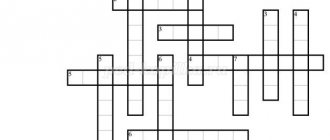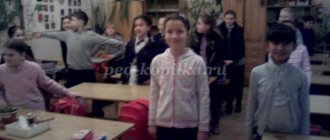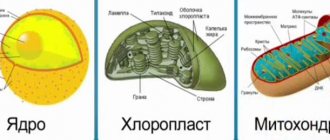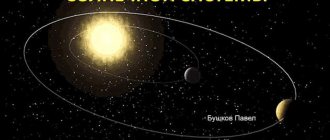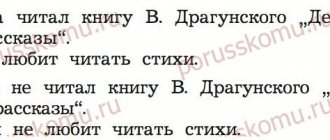Biology lesson notes for 6th grade. What is the difference between living and non-living things?
Summary of a lesson in biology for the 6th grade on the topic: “How living things differ from non-living things”
Author: Svetlana Nikolaevna Frolova - Biology teacher of the branch of the MBOU Murzitskaya Secondary School - Kochetovskaya Secondary School Purpose: to form in students an idea of the main signs of living things and the interaction of a complex of signs in the life of living things organisms. Objectives: Educational: teach students to identify the main signs of living things; Developmental: develop the ability to analyze and compare living and inanimate nature; continue to develop skills in working with the textbook; Educational: to cultivate a love for the nature of the native land. Equipment: indoor plants, a stuffed bird, an aquarium with fish from a living corner, an illustration of a mushroom in a clearing, P.I. Tchaikovsky’s musical composition “The Nutcracker” - “Waltz of the Flowers,” signs with signs of living things. Lesson plan: 1. Organizational moment.
2.Updating. 3. Studying new material. 4. Reflection. 5. Consolidation of the studied material in lesson 6. Homework. During the classes
1. Organizational moment
The teacher welcomes the students.
2.Updating.
Teacher: Listen to the following musical composition (P.I. Tchaikovsky “The Nutcracker” - “Waltz of the Flowers”). What is this work about? Answer: flowers, living nature Teacher: In biology lessons we will study living nature. Since ancient times, it was she who inspired composers and poets to create their masterpieces. The most famous works of great poets, artists, sculptors and composers glorify the beauty of living nature. The teacher talks with the children about famous poets, artists and composers, asks them to name their works about nature and reproduce excerpts of poems. Teacher: Even doctors, in order to calm the patient’s nervous system, advise him to spend more time alone with living nature, listening to its sounds, inhaling its aromas and admiring its beauty. 3. Studying new material Teacher: From this year you begin to study the science closest to the human body - biology. He talks with the guys about the importance of science for human life, its place in nature and the need to protect all life on Earth. Teacher: How does living nature differ from inanimate nature? Listens to students' answers.
Divides the children into groups, gives them various objects and asks them to compare them with each other over a certain time. 1. Group: Houseplant and pointer 2. Group: Stuffed bird and aquarium fish 3. Group: Chalk and a mushroom growing in a clearing (picture)
Discussion of the groups’ answers. Based on the students’ answers on the board, the teacher briefly notes the general characteristics of all living organisms. Summing up. The signs of living organisms are identified. Teacher: Guys, let's write down the main signs of living things in our notebooks. Opens pre-prepared signs on the board.
Diagram on the board:
The teacher gives the students the first idea about metabolism, the students write down the definition in their notebooks.
Teacher: Guys, it turns out that all living things consist of small cells - cells.
We met them in the 5th grade natural history course. Remember and name the main parts of the cell. Listens to children's answers.
4. Reflection
Teacher: Guys, guess about a living or non-living object that will be discussed in my next questions. Questions:
1. In spring, icicles begin to hang from the roofs of houses.
If you observe one of them during the day, you will notice that in the evening its size increases, it becomes thicker and longer. What property of living things is present here? (GROWTH) Based on this, can icicles be classified as living nature? (NO) 2. Scientists have noticed that in the desert sand emits gases during the day due to the fact that it heats up in the sun, and at night absorbs them again due to the fact that it cools down. Does the process of breathing take place here? (NO) Is it possible to classify desert sand as living nature on this basis? (NO) Listens to and discusses student responses. Children come to the conclusion that an organism will be alive when it possesses the entire complex of signs of being alive. Teacher: Guys, what new did you learn in class today? Teacher: What was difficult for you to study today? 5. Reinforcing the material learned in the lesson Teacher: Open your workbooks and complete tasks 1-5 in them. After the students have completed the tasks, he begins to check the correctness of their completion by asking the children orally about questions
6. Homework Teacher: Read paragraph No. 1 at home and remember the basic properties of living things.
We recommend watching:
Summary of an extracurricular activity in biology for 6th grade Extracurricular activity in biology. Scenario for 6th grade Methodological development of an extracurricular activity in biology, 6th grade Synopsis of the integrated event “Fine arts, literature and biology”, 6-7th grade
Similar articles:
Summary of a biology lesson for 6th grade on the topic “Photosynthesis”
Summary of a biology lesson on the topic "Fruits" 6th grade
Biology game, 6th grade
Biology erudite competition, grades 6-7
